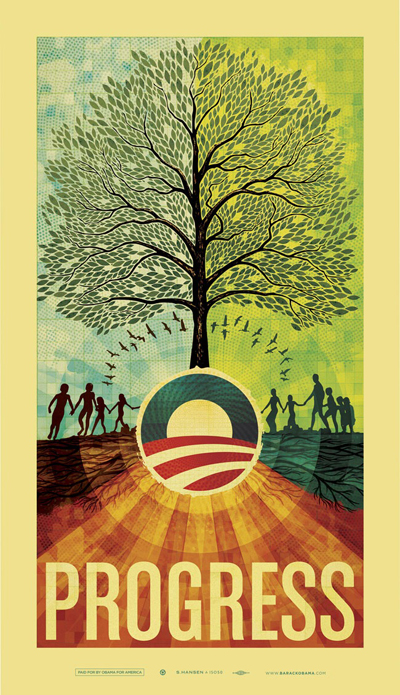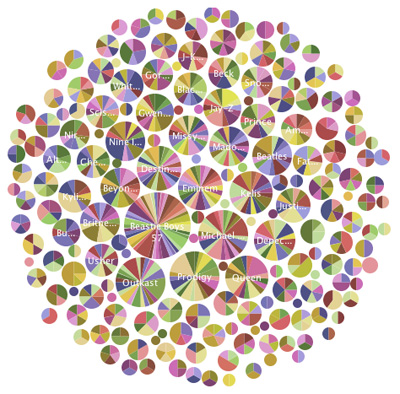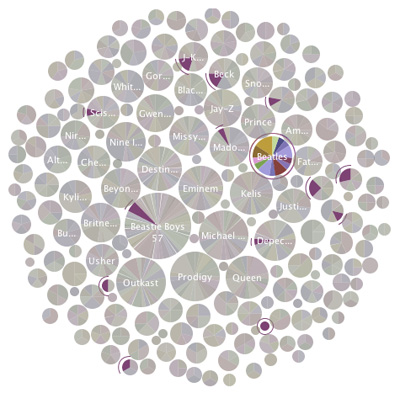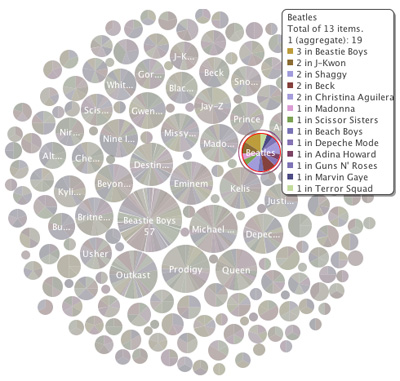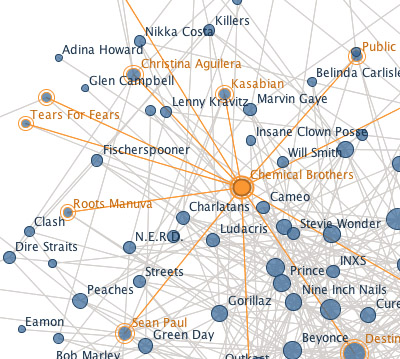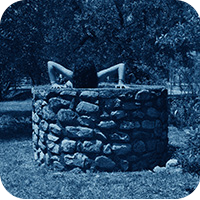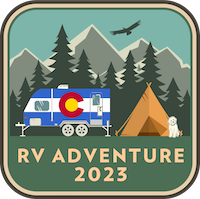OO5
A short note to let you know that I am pleased to be part of the 2009 incarnation of Out of 5, a weekly theme-based mix site put together by Andrew and nine of his pals. The mixes are only up for a week, so grab them while you can. (Alerts via toot, here.)
This week’s theme: songs about resurrection, coming back to life, returning, resurfacing. Perhaps a theme more suited to April and T.S. Eliot’s The Wasteland, but we have to stay optimistic here in Chicago, spiritual home of seasonal affective disorder.
And yes, it took every shred of restraint not to submit the theme music to Return of the Living Dead, obviously.
Now just to kickstart breakbeatbox and we’ll be off to the races.
This is your tongue on LSD
Last night at a dinner party our host introduced us to something amazing.
After dinner but before dessert he passed around a box full of small red berries. We were instructed to take one, put it in our mouth, peel it with our teeth, and suck on it for about a minute. It was pleasing, somewhat sweet.
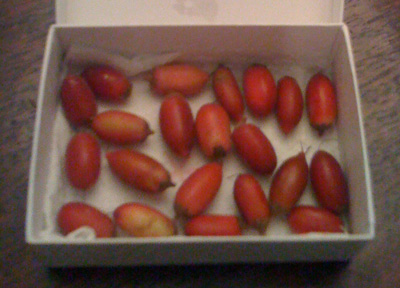
The berry is called the Miracle Fruit. What makes it special is a molecule in it, called miraculin, which binds to the tongue’s taste buds and tricks them into mistaking sour for sweet, a synesthetic bait-and-switch that your mind struggles to comprehend.
Among other things we munched whole lemons (tasted like oranges), dill pickles (like huge gherkins, only sweeter), and drank straight vinegar (like Capri Sun). The effect lasted about an hour and had us scavenging the pantry for anything we could sample with our hallucinating taste buds.
It might be the best dinner party parlor trick ever.
Turns out these berries come primarily from Ghana where they were first employed to take the edge off of palm wine (which I can attest is mouth-invertingly sour). They are mostly a novelty in Ghana still; unlike the blister nut, there’s no export market.
NPR has a story on the berry from last year.
Christmas in hell
There are many ways to ruin Christmas. Crappy gifts, drunken co-workers, eye-searing sweaters, family itself. (Hollywood makes a mint on the mini-genre of mirth-to-misery.)
But I’d like to go deeper than that. I’d like to attempt to scar your subconscious. I want to slice into that corner of your childhood memories that is still very fond of Christmas music. Sure, you say you hate these tunes now, that the infernal jingling-bells-makes-a-song-Christmassy trick makes you want to gore your ear with a flaming yule brand.
But you lie. And I would like to help you confront that lie, to eradicate the joy.
Back in the 1990’s, in the final supernova of cassette tape usage before its demise at the hands of digital, my pal ASG made me a unique holiday mix: the kristMess tape. Much of it is thick atonal drum-and-bass, but the nugget at the center is the gift beneath the bow. My gift. To you.
O Come All Ye Faithful, excerpt, 2:13
V/VM, The V/VM Christmas Pudding
Feel free to use this liberally throughout the next week as circumstances dictate. If Ebenezer and the Grinch aren’t cutting it for you and holiday horror doesn’t set you back on the right path, just put this on loop and relax. Halloween is only ten months away.
See also: Carbone Dolce
Around the World
Certainly there was sweat. Our battered hands prove there was blood. And in fact it ended, for some, in tears. Yes, folks, the silence on this blog can be explained in only one way. We’ve pulled off another holiday party. And avoided arrest, even.
Above: Around the World Timelapse from John Tolva on Vimeo. Timelapse from my laptop camera (right) and a second one (left) pointing out from the DJ booth. (Higher-resolution version)
We’ve done this a few times before. In fact eight times before, when planning had primarily been logistical: How do we accommodate as many people as we want to invite? How do we feed them? How do we make sure they don’t slink off to any other soireés?
But we’re beyond that now, having basically mutated the gathering into a nightclub-meets-Norman Rockwell split-level affair. For as long as we run this little shindig we’re going to be dealing with the bounty of what we’ve sown — a bumper crop of merry-makers ready for (in fact, expecting) one hell of a party.
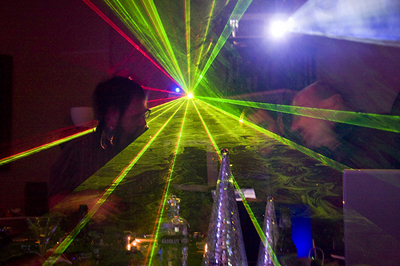
It started, as so many things do, drinking at a bar. Vacationing in Kennebunkport, Maine this June my wife and I had been pondering a theme for the party, the glue that ties it all together. Last year was the first time we’d really used a theme (“Naughty/Nice”) and it was a useful, light framework to hang all the party pieces from.
But themes are tough. There’s a reason you don’t have Star Trek birthday parties any more. (Really, put the tricorder and confetti away.) Seasonal themes seem right but are blasé. Joy to the world? Yay. We liked “naughty and nice” because it had other undertones, but really that was the limit.
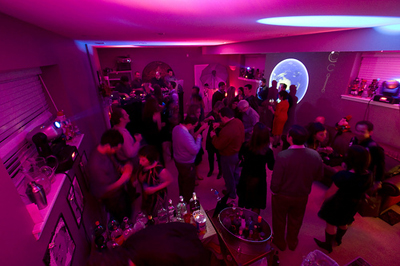
I suppose because we were on a vacation in a new place and because my travel this year had been so frequent and diverse that it was natural that we’d land on “Around the World” as a theme. Initially it was Christmas Around the World, à la1 the MSI exhibit, but we quickly ditched that from the sheer amount of work it would take to pull off convincingly. All we had to do was avoid the extremes of foreign Christmas traditions (too complex, not exactly fun) and collegiate “around the world” drinking parties (too formulaic and, um, college) and we’d be just fine. We thought.
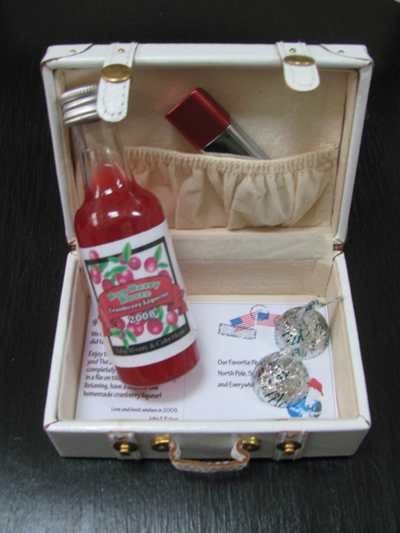
The favor was always intended to be a piece of luggage. Just when we were going to settle for flimsy junk we stumbled on to these beauts. Surely they are custom creations because none of them are exactly the same and they were exquisitely crafted.
Inside went this year’s music mix. I finally ditched the CD (and, sadly, the Jewelboxing packaging that always accompanied it) in favor of a USB memory stick full of tunes and a short video. I had naïvely2 figured that with the ever-falling cost of RAM a few dozen 64MB keys would be at most $100. Wrong. That particular price graph ain’t linear. But I’m no economist and just didn’t want to mess with burning CD’s. We settled on 1GB keys and I filled them with our family’s favorite music of the year.
I’d love to know what percentage of the 100+ guests actually loaded the music onto their systems. One guest said she could not get the “whistle” to make any noise.
The favor also contained some treats and a postcard-style message to our friends with (bonus!) a mini-version of our holiday card on the back. Postage, saved.
Of course, there was hooch. There’s always hooch. After last year’s re-fermenting bottles of homemade raspberry wine exploded in people’s homes (“Happy Holidays! Here’s a timebomb of bright red liquid!”) we almost ditched the tradition. But no. Obviously we needed mini-liquor bottles like they serve on airplanes.
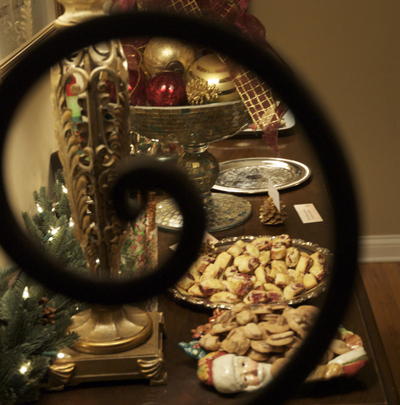
Bottle procurement proved very challenging. The brain trust in the Chicago city council apparently decided recently to ban the sale of mini liquor bottles citing them as being favorites of alcoholics. I found this out by asking our local liquor guy who explained to me the rationale as he served up a flask-sized bottle of liquid fire to an obvious alcoholic just stumbled in from the street. Ultimately I hauled myself just outside of the city limits and bought the cheapest minis I could find. The alcohol in which formed the foundation of …
Homemade cranberry liqueur! For the first time ever, we did not ferment or distill anything ourselves. Instead we essentially mixed up a massive cocktail. We used fresh cranberries (following this recipe and adding in some things like ginger and lime) so we still got to enjoy the annual festival of crushed fruit nastiness in the bathroom. Tolva liquor, like laws and sausages, is something you simply do not want to see made.
With a screw-on bottle top and no moonshine-grade alcohol (lethal quantities of ginger, another matter) you might think this was the first party with nothing booze-related that might kill you. You would, of course, think wrong. Robyn ran with the theme and ordered little metal airplanes shaped, seemingly, from paper clips and meant to attach to the lip of a drink glass. Cute, sure, this twisted metal — but also nearly invisible if dropped into your drink. No reports of GI tract lacerations from anyone, so far.
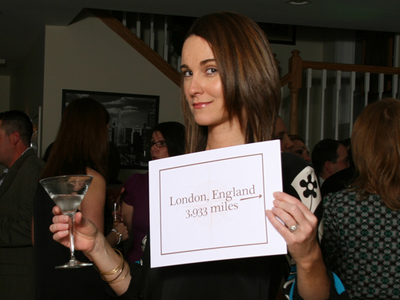
The drinks are designed for whim and power. Pretty sure we succeeded on both fronts. Budget cuts forced us to ditch the ice luge, but we made up for it with globe liquor dispensers serving Rumple Minze and Jägermeister3 like magma from the breached core of the planet. This was the downfall of many guests, I believe.
There’s a degree of pity one has for hired bartenders at our parties. It’s loud and crowded and my wife’s specialty beverages are only slightly less difficult to handle than her wrath if the drinks are improperly made. But Jim the Bartender did marvelously. I even caught him dancing a bit in the four square foot veal pen we gave him to operate in. The menu included Cruising at 37,000 Feet (white cranberry Cosmopolitan — cloudy, you see, with killer airplane clips), Around the World in 80 Proof (rum punch), The Red Eye (Espresso Martini — a crowd favorite), The French Connection (French Martini), and Roman Holiday (Italian Bellini).
Also brought out late were “TSA Blues” shooters — blue raspberry mixer, vodka, and white cranberry juice — served in security theater-approved three ounce containers. I suppose we should have made guests take off their shoes and unload their cell phones while taking the drink. And, lest you think we actually succeeded in classing up this affair past a college party boozefest, a friend showed up with red and green Jello shots late night. You would have thought she was doling out nuggets of purest gold. They went instantly.

(Here’s the recipe.)
The food. Yeah, that. Possibly the only thing that has remained constant in nine versions of this party is a firm ban on catering. My wife enlists assistance from friends, but basically the spread is and forever shall be all hers. Year-to-year favorites include Texas chili con queso (con Fritos FTW!), bacon-wrapped dates (a near-perfect texture-taste match), cheesecake lollipops, and pepperoni bread. Newly added to acclaim were corn cakes with BBQ brisket, sausage-stuffed mushrooms, and chicken satay bites.
One clever idea from Robyn was to put up a map and have people mark their 2008 travels on it. If nothing else it was a conversation starter, but it looked cool by the end of the night, especially since we had folks in from all parts of the country and — this year’s long-haul winner — Ricky Thorpe came from Helsinki via his home in the UK.
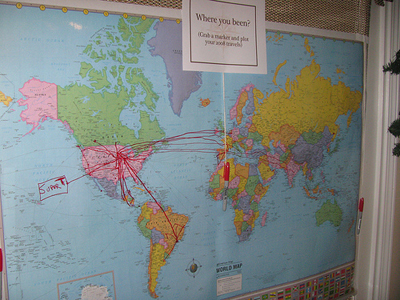
I can’t encounter a geospatial data set and not want to do something with it, so here it is transcribed to Google Maps. Suggestions on how to further extend this most welcome.
The map and out-of-town visitors was the inspiration for this year’s photo “booth” props. We had a few dozen “x miles to y” signs printed up, though it isn’t as though anyone needed prompting to vamp in front of the camera.
And yet, none of this is why people really attend the party these days. Or, at least, it isn’t why anyone stays. This year the basement reached its apotheosis as a full-fledged nightclub. And the club-goers responded.
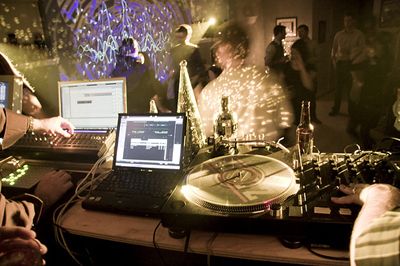
The transformation of the basement is, by far, the most time-consuming, complex undertaking of the whole deal, basically starting right around Halloween.
First thing is to get nearly every piece of furniture out. It’s physically exhausting, logistically challenging (“do you really think we should put that chair in the rafters?”), and psychologically unsettling. My desk, center of a not altogether stable universe to begin with, has to be disassembled — leaving me a laptop-toting nomad in my own home.
The biggest upgrades this year were a huge leap in lighting and the introduction of turntables. Last year’s lighting was an afterthought (though I am still proud of the LEGO disco lights). This year it was the first thought, thanks to the ridiculous inventory and commitment of Tom Herlihy. One night in November Tom came by and loaded several thousand dollars worth of gear into my garage. Robotic spots, LED cans, pattern generators, strobes, projectors, a haze machine, a laser (yes!) — and that was just the stuff I ended up using. There were dozens more.
The best part, though, was Tom’s mastery of the visual machinery; he wired all the lights up using the DMX protocol and hooked them into this control app. Tom set up all kinds of cues — all spots rotate to bartender (i.e., “the DJ needs a drink!”), LED chases around the room, a laser “surface” above dancers’ heads, etc — and controlled it all by touchscreen.
In addition, Tom’s mutant-huge AV laptop powered the visuals on the screen built into the DJ booth and the projector that threw to the back wall. We had all kinds of funky beat-responsive geometries on the screens, but the best may have simply been the rotating globe courtesy of Google Earth. The visuals transformed the space utterly. Tom is my hero.
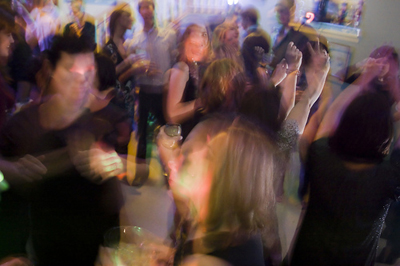
Of course, if you read this blog with any regularity you know that what I really care about is music. And this is how the story figuratively and, as it turns out, literally ends. If Tom was the hero of the visual, Jesse Kriss was the hero of the aural.
Jesse is truly a superstar. He’s a colleague at IBM (creator of one of my very favorite projects), but I first came to know him by way of his Visual Scratch and History of Sampling work. (He’s also my collaborator on the moribund breakbeatbox site. Really should get that going again.)
Anyway. Jesse came in from Boston … by train. He’s a turntablist at heart so he brought a kickass mixer and we rented two decks in Chicago. This was all hooked up via Serato Scratch such that he could control digital music with all the tactile control of old school vinyl.
It was perfect. For one, in the era of laptop DJ’s people go even wilder to see someone actually, you know, doing something to make the music. (The night before as we set up and rehearsed my mother-in-law noted to my wife “They’re all up there with headphones on pushing buttons.”) But also it was a perfect accompaniment when my brother or I were playing the main music. Jesse would drop in beats or scratches, on-the-fly annotation of the stream of tunes.

We had some issues recording everything (with seven laptops up there you’d think we’d have been OK), but I did manage to get a portion of Jesse’s set. Probably the highlight of the night was when he layered in portions of Obama’s election night speech. I thought a certain female supporter of the president-elect in the crowd was going to jump up and rip his clothes off right then and there. (Note: Jesse is working on an inauguration mixtape. A must-post when it is released.)
I had my usual rig set up with Ableton and the monome ready to control an atomized version of Daft Punk’s “Around the World,” the obvious theme song of the whole night. You can hear one version of it (we dropped it in throughout the evening) in the set below. That moment, as I hazily recall, was probably the most raucous. Everyone singing, everyone moving.
John Tolva, Around The World 2008 (1:59:53)
My brother rounded out the DJ lineup, keeping the tracks young enough for everyone to pretend we were hip. Joey was the designated Rickroller dropping ol’ Astley in from time-to-time to the delight of some and confusion of most.
With Tom on the visuals and the three musicmakers in the booth we were a uniquely dorky quartet, but a few different people noted that it looked like we were having a blast. We most certainly were. I’d do it again even without a crowd.
In fact, I just may. For one, I ignored just about every request that came my way so it isn’t like I was reading the crowd. For another, the DJ booth got a massive overhaul this year and I’m reluctant to tear it down. It was much wider, more stable, and roomier (with space for a projection rack behind us). But the clear killer feature — added only hours before the party by the industrious Jeff Greer — was carpeting. That’s right, it was plush bordering on posh up there in mission control. I just can’t bear to part with that degree of luxury.
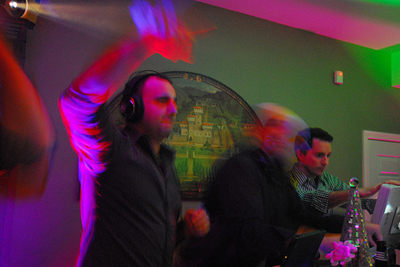
All this music was pumped through a dedicated sound system, also courtesy of Tom. No more tripping the circuit of our media center amp. (Actually we deliberately overloaded the circuit box about a week before the party to see how far we could push it. Tip: watch the strobes.) The bass was delivered from a monstrous four-foot-cubed subwoofer tucked into the corner — a seismic rumbler that surely shook our neighbor’s foundations.
How can I be so sure? Well, the police told me so. Around 3AM when the basement was still thumping Chicago’s finest showed up and declared the party over because of “multiple” complaints from neighbors about the noise. Given that our neighbors on one side were actually at the party, I’m fairly certain I know who was complaining. Guess I better invite them next year.
Actually I think I’m to blame. It was fairly toasty down in the basement (I thought, though few others did) so I cracked the windows. This, I bet, was the source of audio leakage that was the ultimate downfall of the party.
And yet, there’s something right about a party of this magnitude not stopping on its own. I suppose we’ve all matured since high school as no one, to my knowledge, fled out the back door when the 5-0 came knocking. The cops actually said they had come by once before in the evening and someone shut the door in their face. Nice.
There were other hijinks this year (and thank god the kids were with their grandparents), but there’s no need to impugn reputations or submit these tales to the Google index for perpetuity.
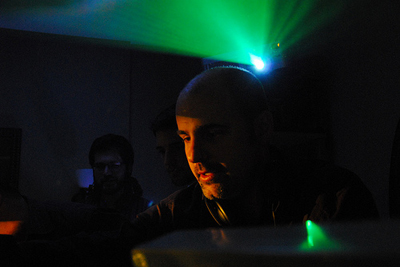
It was a spectacularly good time. With the sole exception of my wife using Comic Sans to create address labels for an otherwise carefully-designed invitation, I think we’d change nothing. (No open windows next year, obviously.) Many complained of a “Tolva flu” the next day, but this is what you get for drinking booze from a globe, or a TSA container, or a Jello mold.
And how many parties have you been to that make the cover of a city newspaper the next day? (Look for the record.)
There is simply no way we could pull this off without the help of our friends. Deep thanks to Justin Bowersock, Kellie Burke, Chris Gansen, Jeff Greer, Tom Herlihy, Alyson Higgins, Jesse Kriss, Ricky Thorpe and Michael Tolva. It is your party too.
See you next year!
Codemusic
Lately I have been loving a few truly innovative audio apps for the iPhone, none having to do with it being an iPod.
I had always thought that mobile audio creation software were frivolous party tricks. Hey, look at me, I can play Baby Got Back on my 3″-wide keyboard! But that’s changed.
A while back I wrote about an idea for including audio processing code in the header of MP3 files. The premise was that, in addition to creating a music track, the artist would provide parameters for real-time playback modification based on user input, randomness, or anything else. The song would never (or at least wouldn’t ever have to) be the same.
The team at RJDJ have taken this idea to the extreme. The free and pay RJDJ apps in the iTunes store both provide “scenes”, akin to music tracks, complete with artwork. These scenes are nothing but audio processing algorithms.
All input happens via the lavalier microphone on the iTunes earbuds. Basically the scenes take the ambient noise surrounding you and remix it. Some of the scenes do this subtly, some are more musical, but all of them make you the focal point of the remix — not so much a musician as a conductor. I’ve listened to the noise of the L train, walking down the street, and the cacophony of three kids at dinner time. It is completely entrancing. Location-based remixing.
So, to our list of traditional musical interfaces — stick hitting animal skin, horse hair pulled across wire — we add one’s physical movement through life’s soundscape.
Here’s a more musical scene based on my eastward walk through the city a few days ago*. Note especially the interpolation of me almost being hit by a cab crossing Michigan Ave. at 1:16 (red marker on map). The horn makes the piece, in my opinion, but the beauty of this particular scene is how the bleeps and bloops are modulated by the ambient street noise.
Of course this map isn’t connected in any way to playback control, but with the iPhone’s GPS it seems like an obvious evolution of the RJDJ app. The possibilities are many. How about a View in Google Maps button in iTunes? Or a site that aggregates user-created tracks and plots them over one another on a map, a personal-social musical-spatial mashup. Dan Hill’s city of sound, indeed.
——–
There are some other apps of note too.
Bloom is a generative music app from none other than Brian Eno, working with Brian Chilvers. You initiate notes of music by touching the screen. Each note plays and interacts with other notes in expanding concentric circles, like dropping pebbles in a pond. As with scenes in RJDJ, the parameters of note interaction are constrained by “moods”. These are the algorithms that govern the evolution of the sounds you start off. Spore for music. (Not a coincidence that Eno did the music for Spore, of course.)
Ocarina is one of those apps that makes you love the creators for thinking of it. Basically Ocarina turns your iPhone into a high-tech flute. OK, you say, I can see touching the screen like you cover the holes of a woodwind, but where do you blow? Why, the microphone of course! They’ve turned the lack of a wind guard on the iPhone mic into a feature! Light exhalation makes less noise on the mic and produces a lower intensity of the current note combination, and conversely. It’s brilliant really.
——–
* There’s no easy way to export audio from RJDJ, but this handy tool allows you to parse the backup file that the iPhone generates on your machine. You can pluck out the .wav files right from the RJDJ folder.
Crowds in Grant Park
People demanding change, a museum fixed in time.
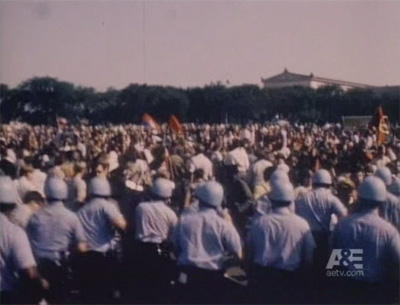
Protesters at the 1968 Democratic National Convention
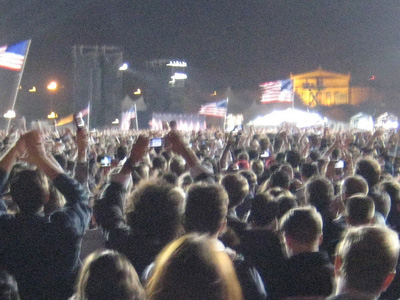
Supporters on election night, 2008
The Mashability Index
A while back my brother gave me several thousand songs from GoodBlimey.com. Almost all the tracks were mashups. Each song was composed of two songs by two different artists fairly equally smooshed together.
All the track titles were in the A vs. B format (e.g., Black Eyed Peas vs Kraftwerk) — and this gave me an idea.
I exported all the track data as a text file. Then my pal Chris Gansen wrote a script that nuked everything except the two artist names for each track and transformed the data into a spreadsheet like this:
A B 1
A C 1
B D 1
C D 3
C B 2
…
Then it was just a matter of plugging the data into ManyEyes and playing with the visualization types. The best by far is the bubble chart view. (Here’s the interactive chart.)Where the first two columns were artists names and the third column was the number of times they were mashed together in unique songs.
Each circle above represents a single artist. The larger the circle the more other artists the selected artist is mashed with.
The color slices actually tell you at a glance which other artists have been mashed … if you are an autistic savant who can pick out a single color in a sea of several hundred chromatic gradations, that is.
Much easier is clicking a circle which highlights the other artists with which it is mashed.
An alternate view gives the most complete information complete with number of mashed tracks per artist combination.
One other useful view was the network diagram. It shows actual connections between artist combos. The best feature of the diagram is that selected nodes highlight all the other artists with which it is matched. Easy to figure out who’s connected to whom. (Here’s the interactive diagram.)
So what have we learned? Certainly my data set does not contain every mashup ever made. But there were thousands and I think the charts give a good sense which artists mash best (look for the big circles) and mash best with whom.
But there’s far more that could be done. For one, there’s no data in these charts on which songs are being mashed. I have the info — just haven’t figured out how to integrate it. What I really would love to get at is why two artists make sense together. This would require stylistic data, notoriously subjective and consequently unreliable. Still, consider this but a start of the analysis.
Two particular projects influenced my work on this index. The History of Sampling by Jesse Kriss is a bar that I didn’t even come close to hitting, but it provided a great place to aim. And Andy Baio’s analysis of the samples in Girl Talk’s Feed The Animals showed what could be done with an idea, Amazon Turk, and some cool visualizations.
In truth, getting this data into shape was a massive pain in the ass. It was horribly formatted to begin with and took a great deal of kicking and shoving to play nicely with Many Eyes. Above all thanks to Chris — but Jesse Kriss, Frank Van Ham, and Martin Wattenberg of the Many Eyes team deserve applause too.
This is a lot cooler than My Music Genome, isn’t it?
Skip St. John
Well, look who has a blog.
My brother has claimed his own parcel of the web (MySpace don’t count, sorry Joey). I look forward to redirecting all our conversation with one another to comments and trackbacks between our sites.
Enjoy: www.skipstjohn.com.
(Clearly the blog title is an affectionate homage to me. Brotherly hagiography, if you will.)
Sightings
Some upcoming talks for those of you who like your rambling in person.
Tomorrow I’m attending the Chicago Colloquium on Digital Humanities and Computer Science at the University of Chicago. It is a small, single-track, free (!) conference that I have wanted to attend for years. I’ll be in the poster sessions, fishing for interest in using our non-profit grid for scholarship in arts and culture.
On Nov. 7 I’ll be speaking at the University of South Carolina in Columbia. The talk is called “Architecting Cultural Spaces: The Past, Present, and Many Futures of Digital Humanities” as they kick off their own Center for study of the same. I’ll post to Slideshare when it is complete.
I’ve had a panel accepted for next year’s SXSW festival. It’s called Entrepreneurship in the Belly of the Beast — basically an anti-SXSW screed about the opportunities for getting away with stuff in a big company. I’ll most likely be booed off stage by startup junkies. Or fired for calling my company the Beast. Win-win.
If you’ll be at any of these events in the coming days and months, please drop a line!

